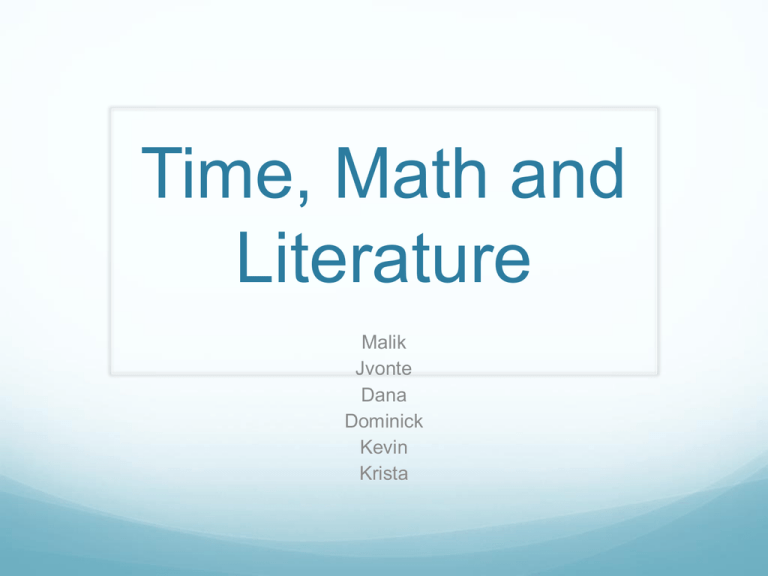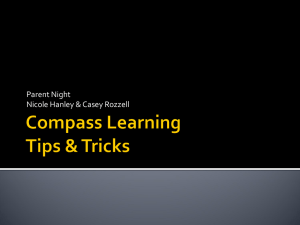Time, Math and Literature
advertisement

Time, Math and Literature Malik Jvonte Dana Dominick Kevin Krista Zeno’s Paradoxes Mention at the end of Borges’s detective story Death and the Compass Stated in the 5th Century, weren’t unraveled until 17th century Were the basis of all the theories of space, time and infinity The Argument Before Achilles can overtake the tortoise, he must first run to point A, where the tortoise started. But then the tortoise has crawled to point B. Now Achilles must run to point B. But the tortoise has gone to point C, etc. Achilles is stuck in a situation in which he gets closer and closer to the tortoise, but never catches him. Achilles Paradox Achilles cannot overtake a fleeing tortoise because in the interval of time that he takes to get where the tortoise was, it can move away Space and time are what we make it Dichotomy Paradox There is no motion because that which is moved must arrive at the middle before it arrives at the end; that is d/2, d/4, d/8, etc…… (1/2)n+1 Infinite number of tasks, in an infinite amount of time. Q: Can the race even begin at all if all final destinations have a half way point, and those half way points have half way points, etc….? Jorge Luis Borges Author of today’s reading-“Death and the Compass” (1942) Through his literature, embodies the convergence of math & philosophy Born in Buenos Aires in 1899; achieved international fame Best known for his short stories, essays, poetry, translations Magical realism & “irreality” Borges was known as a magical realist The Aleph (1944) Ficciones (1949) A reaction against the realism and naturalism of the nineteenth century Borges’s blindness and imagination Magical realism: Creating space for exploring concepts like time Themes in Borges: Time & labyrinths Doodle depicts 'a wide, fantastic architecture scenery', says Google. Photograph: Google “I know of one Greek labyrinth which is a single straight line. Along that line so many philosophers have lost themselves that a mere detective might well do so, too. Scharlach, when in some other incarnation you hunt me, pretend to commit (or do commit) a crime at A, then a second crime at B. . . . then a third crime at C. . . . Wait for me afterwards at D. . . . Kill me at D as you now are going to kill me at Triste-le-Roy.' 'The next time I kill you,' said Scharlach, 'I promise you that labyrinth, consisting of a single line which is invisible and unceasing.' He moved back a few steps. Then, very carefully, he fired." [Excerpt from “Death and the Compass”] Themes in Borges: Time & labyrinths (continued) La Biblioteca Nacional Buenos Aires “The Library of Babel” “The Circular Ruins” Poetry, architecture, the streets of Buenos Aires… 1) What concept of time might the labyrinth draw upon? 2) How does Lonnrot’s conception of time oppose this notion? Themes in Borges: Time, infinity, quantum physics Library of Babel “The Book of Sand” rejection of absolute time; time concept of infinity "The Garden of Forking Paths” non-linear time (quantum mechanics; multiverses in some versions of string theory) How is the time concept of infinity reflected in “The Death and the Compass”? Give a few examples. Hear No Evil-Speak No EvilZeno No Evil “This Must be illegal by Logic’s own laws, Yet try as I might, I could not find the flaws” (12-13) Zeno vs Mathematics vs Time/Space In real time and space we will eventually reach the end point “And my downfall I owe to the cunning of Zeno, Who showed that the truth lies NOWHERE in between-0”(28-29) Final Statement is a paradox in itself Regardless of what Zeno thinks, There is an end Three murders (?) Lönnrot - detective A rabbi is killed (stabbed) in his hotel room on December 3rd , so he’s assigned to the case The rabbi left a mysterious message on the rabbi's typewriter: “The first letter of the Name has been uttered.” After reading the rabbi’s many books, he connects the message with the Tetragrammton, the four letter name of God January 3rd - a second crime takes place with the message “The second letter of the Name has been uttered” left behind February 3rd, - a third crime: “The last letter of the Name has been uttered” All happening a month apart on the 3rd (at first) Four murders? Tetragrammaton contains four letters, two of them being the same letter repeated - YHVH The murders actually took place on the 4th of December, January and February because of the Jewish calendar: the day begins at sunset and the murders happened after sunset Lönnrot predicts that there is one more crime The detective's office receives an anonymous tip to view the map locations of the crimes, which equals an equilateral triangle Lönnrot makes a rhombus - the southern end of the city has yet to see a crime The last crime location is the chateau Triste-le-Roy, Lönnrot suspects Labyrinth, Zeno and the fourth murder Lönnrot gets there a day earlier to catch the criminals, but he is fooled! He is trapped in a labyrinth Scharlach, one of the most famous criminals, reveals this trapping is revenge for Lönnrot arresting his brother, leaving him to suffer Scharlach planned the whole scenario and supplied the map to lead the detective there to his death! Lönnrot, first very scared and then surprisingly calm, says Scharlach made his labyrinth too complex It should have been just a single line, with each crime taking place on the halfway points - A 8 km from B, C 4 km from each, D 2 km from A and C. Lönnrot refers to Zeno’s Paradox – philosophers have been struggling with this line for years, and he should not be excused Scharlach promises that he will trap Lönnrot using Zeno’s Paradox (the line) in the next lifetime. He shoots. Questions Do you think Scharlach deserved taking out his revenge on the detective? Do you think a line would have been more effective in terms of his plan? In reference to time, could we say that the story is ongoing due to their belief in the afterlife? Math in “Death and the Compass” Compass – instrument for drawing circles and arcs and measuring distances between points Math in “Death and the Compass” Math in “Death and the Compass” It seems Like Lonnrot is a straight and forward math guy because his use of it in the investigation, but at the end of the story he seems to have more belief in Zeno’s Paradoxes. He begins the to think the House is eternal Reassures himself that it only appears so by the symmetry of the house. Math in “Death and the Compass” “I suggest you fake one crime at A, then a second crime at B, 8 km from A, then a third crime at C, 4 km from A and B, halfway in between them. Then wait for me at D, 2 km from A and C, once again halfway between them. Kill me at D, as you are about to kill me at Triste-le-Roy.” Math in “Death and the Compass” My Question??? Do you think Lonnrot is more of a Mathematician or a critical philosopher like Zeno?









